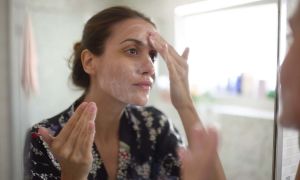Advertisement
Androgens, or sex hormones, play a critical role in acne on many levels. Simply put, if there are no androgens, there is no acne. However, androgens alone are not the sole cause of acne since many other factors are also involved, such as bacterial overgrowth, skin cell differentiation, and skin cell stickiness.
Specific hormone levels increase during puberty and cause the sebaceous glands to increase production of sebum, a prerequisite for acne. This is why acne is generally worse in areas where there is a higher density of sebaceous glands, such as the face and upper back, and generally absent in areas where you don’t have any sebaceous glands like the elbows and the feet.
There are two ways these hormones affect acne. In some people, too much hormone is circulating in the blood, therefore triggering acne. In most acne patients, however, there are normal blood levels of androgens, while there is an increased and inappropriate responsiveness of the pilosebaceous unit to a normal amount of circulating androgen. This means that even though all the blood tests come back normal, your body is overly accepting of the androgens that are circulating in the blood. The end result is acne.
Before the onset of puberty, between age 7 and 8 years, the adrenal glands produce increasing amounts of androgens called dehydroepiandrosterone sulfate (DHEAS) and testosterone, which in turn can be metabolized to more potent androgens that cause the sebaceous gland to enlarge and increase sebum production. As girls mature, the ovaries take over this role from the adrenal glands, for the most part. The serum level of DHEAS correlates with the severity of comedonal acne in prepubertal girls. In addition, acne severity increases with sexual maturity in both sexes.
Both boys and girls may have acne that is related to increased sensitivity of the sebaceous glands to androgens. In girls, excess production of androgens may also cause acne, particularly when it occurs in older girls/women, is persistent, or is associated with increased hair growth on the face. In girls with acne caused by high circulating androgen levels, free testosterone and DHEAS may be present. Low levels of a protein called sex hormone-binding globulin may also be observed. Sex hormone-binding globulin attaches to testosterone and helps keep it from affecting the skin. A lack of this globulin translates into greater amounts of androgen circulating in the blood, able to affect the skin.
Specific hormone levels increase during puberty and cause the sebaceous glands to increase production of sebum, a prerequisite for acne. This is why acne is generally worse in areas where there is a higher density of sebaceous glands, such as the face and upper back, and generally absent in areas where you don’t have any sebaceous glands like the elbows and the feet.
There are two ways these hormones affect acne. In some people, too much hormone is circulating in the blood, therefore triggering acne. In most acne patients, however, there are normal blood levels of androgens, while there is an increased and inappropriate responsiveness of the pilosebaceous unit to a normal amount of circulating androgen. This means that even though all the blood tests come back normal, your body is overly accepting of the androgens that are circulating in the blood. The end result is acne.
Before the onset of puberty, between age 7 and 8 years, the adrenal glands produce increasing amounts of androgens called dehydroepiandrosterone sulfate (DHEAS) and testosterone, which in turn can be metabolized to more potent androgens that cause the sebaceous gland to enlarge and increase sebum production. As girls mature, the ovaries take over this role from the adrenal glands, for the most part. The serum level of DHEAS correlates with the severity of comedonal acne in prepubertal girls. In addition, acne severity increases with sexual maturity in both sexes.
Both boys and girls may have acne that is related to increased sensitivity of the sebaceous glands to androgens. In girls, excess production of androgens may also cause acne, particularly when it occurs in older girls/women, is persistent, or is associated with increased hair growth on the face. In girls with acne caused by high circulating androgen levels, free testosterone and DHEAS may be present. Low levels of a protein called sex hormone-binding globulin may also be observed. Sex hormone-binding globulin attaches to testosterone and helps keep it from affecting the skin. A lack of this globulin translates into greater amounts of androgen circulating in the blood, able to affect the skin.

More About this Book
100 Questions & Answers About Acne
100 Questions and Answers About Acne provides you with all the information you need to manage your complexion problems. Written by Dr. Doris J. Day, a world-class expert in the field, this clearly...
Continue Learning about Acne
Important: This content reflects information from various individuals and organizations and may offer alternative or opposing points of view. It should not be used for medical advice, diagnosis or treatment. As always, you should consult with your healthcare provider about your specific health needs.




